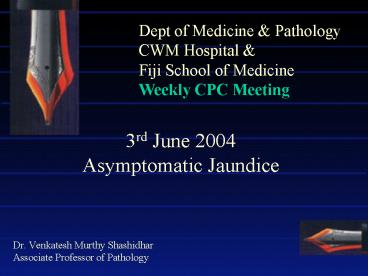3rd June 2004 Asymptomatic Jaundice - PowerPoint PPT Presentation
1 / 12
Title:
3rd June 2004 Asymptomatic Jaundice
Description:
17 year old Fiji Indian male. Chronic jaundice, no other symptoms. ... Cholelithiasis (pigment stones) is common and may be the cardinal symptom at presentation. ... – PowerPoint PPT presentation
Number of Views:95
Avg rating:3.0/5.0
Title: 3rd June 2004 Asymptomatic Jaundice
1
3rd June 2004Asymptomatic Jaundice
Dept of Medicine Pathology CWM Hospital Fiji
School of MedicineWeekly CPC Meeting
- Dr. Venkatesh Murthy Shashidhar
- Associate Professor of Pathology
2
Patient details
- 17 year old Fiji Indian male
- Chronic jaundice, no other symptoms.
- On examination spleen 1 palpable.
- Laboratory Bilirubin 60-70mg/dl, predominantly
unconjugated. - Full blood count results normal.
- High reticulocytes 20 and repeat 22
- Hb 12.0gm.
3
Patient details
- Liver function tests within normal limits
except high bilirubin. - Provisional diagnosis of chronic hemolytic anemia
? Cause. - Blood film showed plenty of spherocytes, moderate
polychromasia and occassional nucleated RBc. - Hereditary Spherocytosis.
4
Blood film morphology
5
Blood film morphology
Spherocytes. Normal
6
Blood film morphology
Spherocytes. Normal RBC
7
Blood film morphology
Nucleated RBC
8
Blood film morphology
9
Discussion Hereditary Spherocytosis
- chronic familial icterus / chronic acholuric
jaundice / familial spherocytosis - a chronic disease, inherited as a dominant trait.
- Hemolysis of spheroidal RBCs, anemia, jaundice,
and splenomegaly. - Although usually one or more family members have
had jaundice, anemia, or splenomegaly, one or
more generations may be skipped because of
variations in the degree of gene penetrance.
10
Discussion
- Mild Symptoms and signs with compensated anemia.
- Moderate jaundice and anemia severe cases.
- Aplastic crises may result from intercurrent
infection may exacerbate the anemia. - Splenomegaly is almost invariable but rarely
causes abdominal discomfort. Hepatomegaly may be
present. - Cholelithiasis (pigment stones) is common and may
be the cardinal symptom at presentation. - Congenital skeletal abnormalities (eg,
tower-shaped skull, polydactylism) occasionally
occur.
11
Discussion
- Several RBC membrane protein abnormalities.
- Cell membrane surface area is decreased impairing
the flexibility needed to pass through spleen's
microcirculation ? hemolysis in spleen. - MCV normal, MCHC is increased. Reticulocytosis of
15 to 30 and leukocytosis are common. - Increased osmotic fragility but normal in mild
cases it may be normal unless sterile
defibrinated blood is first incubated at 37 C
(98.6 F) for 24 h. - Direct antiglobulin (Coombs') test is negative.
RBC autohemolysis is increased and corrected by
addition of glucose.
12
Treatment Prognosis
- Splenectomy is the only specific treatment
- Indicated in patients lt 45 yr with severe anemia
(Hb lt 10 g), jaundice or biliary colic, or
aplastic crisis - Before splenectomy, the patient should be
immunized with pneumococcal and Haemophilus
influenzae vaccines. - During splenectomy, a gallbladder with stones or
evidence of disease should be removed. After
splenectomy, symptoms usually abate, the RBC
count rises, and the reticulocyte count returns
to normal. Because spherocytosis persists, RBC
fragility of the blood is still increased, but
the patient is improved because the filter
(spleen) for these abnormal cells is absent and
the cells survive longer in the circulation.































